This post may contain affiliate links.
The Best Bernini Statues in Rome
Gian Lorenzo Bernini is one of the most famous Italian sculptors ever to come out of Italy.
His work is renowned for its frothy beauty, delicate detail, and dramatic intensity, and I – along with thousands of other culture vulture travellers – can’t get enough of it.
As a huge fan of Baroque art (and art and travel in general), I went on a quest to find the top Bernini sculptures in Rome – and dove into some shocking scandals along the way.
If you want to check some stellar Bernini statues for yourself, follow my journey into this fascinating era of art.
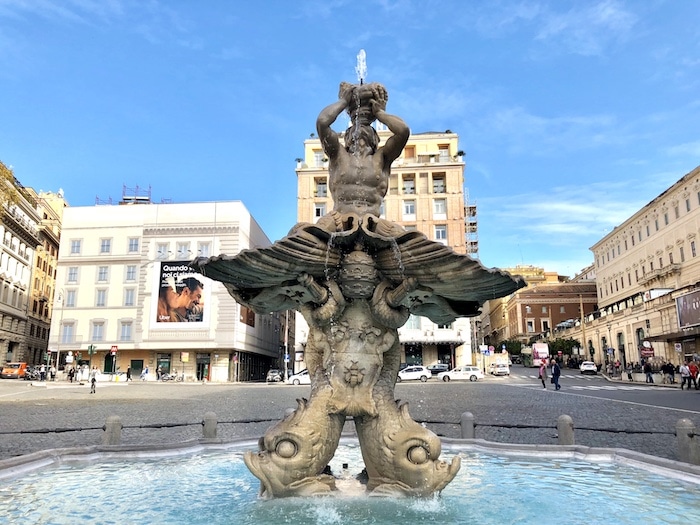
Bernini Sculptures at the Borghese Gallery
I started my Bernini tour at the Borghese Gallery and the audio guide was messing with my head.
Anecdotes about Rubens were rattling into my ear while I was looking at a painting by Caravaggio. Then I realized I was in the wrong room.
While the narrator talked on, I gave up and simply enjoyed the sensation of being enveloped by the marble sculptures and sumptuous interiors of the Borghese Gallery, the former villa of the art-mad Cardinal Scipione Borghese.
My goal was to revisit the museum’s famous Bernini sculptures, particularly Apollo and Daphne. It’s a statue so gossamer and alive it’s hard to believe it’s marble rather than snow.
Who was Gian Lorenzo Bernini?
A 17th-century master sculptor and architect who had the ear of the pope, Bernini changed the face of the city.
Together with the painter Caravaggio, he’s one of the poster boys of the Baroque, a period in art that embraced the theatrical, the lavish and – one might argue – the overdone.
From the Four Rivers Fountain in Piazza Navona to the monumental Baldacchino at the Vatican, Bernini’s work makes up some of Rome’s top attractions.
All statues create shadows, however, and there are tales to discover behind these great works of art.
Get your Skip-the-Line Borghese Gallery Tickets here.

A Dark Spot in Bernini’s Career
I’d just tracked down The Rape of Proserpina in the Borghese’s Emperor’s Room when the audio guide narrator said something that made me stop.
He was talking about the one dark spot in Bernini’s career.
Pope Innocent X had just ascended to power and he wasn’t as devoted to Bernini’s artwork as Pope Urban VII had been. Projects were going to Bernini’s despised rival, Francesco Borromini, instead.
His star seemed to be fading.
But I’m like, what? What? The one dark spot?
The Other Dark Spot in Bernini’s Career
I looked around for my husband so I could tug on his sleeve and register my indignation but he was engrossed in Canova’s reclining sculpture of Paola Bonapart Borghese, which, admittedly is quite risqué, and Mark was more interested in listening to his headset than to me.
Fine. I’d talk to myself.
What about the other dark spot in Bernini’s career? The affair he had with Costanza Bonarelli, the wife of his assistant?
I learned about it years ago when I was in Italy writing a travel article for the Toronto Star, and I’d never forgotten what followed.
Who was Costanza Bonarelli?
Sensual, young and plumply pretty, Costanza was not only married but managed to fit in an affair with Bernini’s brother, Luigi, too.
When the besotted Bernini saw his brother leaving Costanza’s house, he was filled with such a rage that he chased Luigi through the streets with a crowbar (breaking two ribs). He then went after him with a sword.
After that he sent a servant over to slash Costanza’s face with a razor.
That’s not a dark spot in Bernini’s career? It’s a big black hole!
So while I can’t help being swept up by Bernini’s talent, and his sculpture of Apollo and Daphne takes my breath away, is it right to gloss over the past?
The real past paints a more accurate picture of the era and offers an eye-opening glimpse into the dark depths of Baroque Rome.
How to Visit the Galleria Borghese
The Borghese Gallery, the Galleria Borghese, is located on Pincian Hill in the Villa Borghese Gardens, one of the largest green spaces in Rome.
The landscaped park is within walking distance from the Spanish Steps or the Via Veneto, but you must get a ticket for the gallery beforehand because it’s one of the most popular museums in Rome.
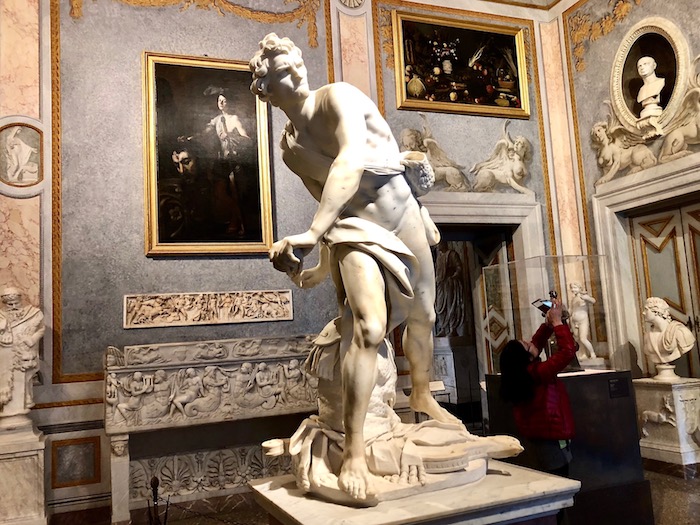
What You’ll See at the Borghese
The Magnificent Beauty of Apollo and Daphne
If you only want to spend one minute on Bernini in Rome, seek out Apollo and Daphne. It’s located in – quite fittingly – the Apollo and Daphne Room at the Borghese.
It was sculpted between 1622 and 1625 when Bernini was still in his early 20s.
Commissioned by Cardinal Scipione Borghese, one of Bernini’s top patrons, it was considered scandalous by some, but it propelled the young artist to fame.
The marble masterpiece captures a windswept moment of change. The lusty Apollo, who has been hit with Cupid’s arrow, has just caught the innocent nymph Daphne.
Terrified she calls out to her river god father to save her.
He transforms her into a laurel tree and this is the moment Bernini has caught.
Daphne’s fingers are turning to leaves, her hair to branches and her feet to root tendrils. Her expression is desperate as Apollo grabs her waist.
It’s an action-packed scene and I didn’t stop circling it until my husband hauled me away.
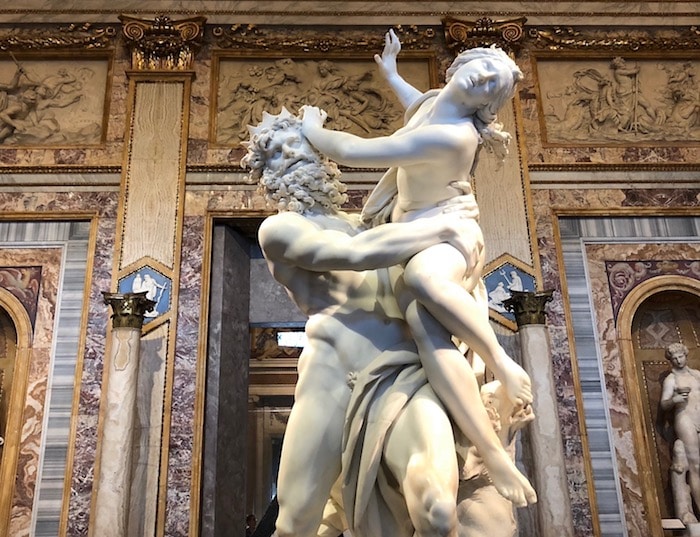
The Bernini David
The Bernini David is one of three famous David sculptures. (The others are by Michelangelo and Donatello.)
David is about to hurl the stone at Goliath. His muscles are taut, his torso turned and his expression is determined.
It’s David as ‘every man’ and Bernini is said to have used his own image as a model.
So now that you have an idea of what he looks like, let’s move on.
The Rape of Proserpina
Also known as Pluto and Persephone, the Rape of Proserpina is another early Bernini masterwork at the Borghese Gallery, and was carved when he was barely 23.
It’s a nail-biting moment.
Pluto, the God of the Underworld, has just kidnapped Persephone, who is twisting and struggling to escape the bearded burly god.
Her helplessness, along with Daphne’s, makes me think of Costanza, the woman who Bernini would fall so violently in love with nearly 20 years later.
Not that Costanza was an unwilling participant – by all accounts it was a passionate pairing that steamed on for two years – but what was her fear when Bernini’s servant was slashing her face?
Were these sculptures somehow prophetic of her struggle? Do they reveal a shard of violence that lay embedded in the Bernini’s soul even then?
Or was it a sign of the times?
Here’s the real dark spot.
Slashing an unfaithful woman’s face was not unheard of in Italy at the time. It was meant to disfigure her and mirror the ugliness of her soul.
The Fallout from Bernini’s Affair
This savage event could hardly go unnoticed, but the pope was unwilling to lose his golden goose of Baroque sculpture.
Bernini got away with a rap on the wrist. He was ordered to settle down and marry.
His intended, Caterina Tezio, was one of the most celebrated beauties in Rome. He was also ordered to pay a fine that was later forgiven by the pope.
Apparently Bernini never strayed again, attended mass daily for the next 40 years and went on to have 11 children. That’s all very fine but what about Costanza Bonarelli?
Costanza went to prison for adultery.
To be more exact, it was an institution for wayward women.
She didn’t stay in long, and when she came out she resumed her marriage, became an art dealer of sorts and her husband continued to work as Bernini’s assistant.
It’s an ending I don’t pretend to understand.
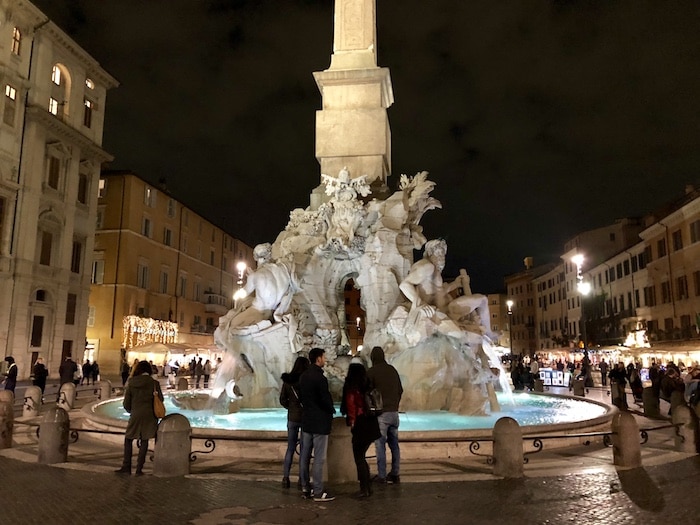
Bernini’s Four Rivers Fountain in the Piazza Navona
The tangled affair of Bernini, his brother, his assistant and Costanza is a soap opera in stone, and their ghosts seemed to hover in the shadows as Mark and I strolled that evening to the Piazza Navona.
When we got there we aimed for the Four Rivers Fountain, the Fontana dei Quattro Fiumi, which is the luminous star of the piazza.
It’s Bernini’s most famous fountain, although a number of other sculptors worked on it, too.
It was completed in 1651 and Bernini only got the commission by some tricky maneuvering.
Still on the outs, he wasn’t invited to submit his design, but he put a model of it under Pope Innocent X’s nose and it was so overwhelming the pope couldn’t turn it down.
The Four Rivers – A Sculpture of the Gods
The fountain shows four muscular river gods. Their feet, dangling down towards the water, surround an obelisk recovered from the Appian Way.
The gods represent the four great rivers of the world: the Danube, the Ganges, the Rio del Plato and the Nile.
These in turn represent the four continents of the world: Europe, Asia, America and Africa.
(Australia hadn’t been discovered yet, and don’t ask me about Antarctica – it’s Bernini’s masterpiece, not mine.)
That all represents the power of Christianity, with the water signifying God’s wisdom that washes over everything.
The Rumoured Scandal of the Four Rivers Fountain
The Fontana dei Quattro Fiumi faces the Sant’Agnesi in Agoni church, another well-known Rome attraction on Piazza Navona.
Bernini may have won the competition for the fountain but he lost out on the commission to design the church to his arch rival, Francesco Borromini.
It’s said Bernini expressed his disdain for Borromini’s project through his gods.
The figure of the Nile hides his face from the sight of the church, while the Rio del Plata god has his hands raised, as if to protect himself when Borromini’s church falls down.
It’s a suspect tale, however, as the fountain was completed before the church – but it does add a bit of dramatic tension to a visit.
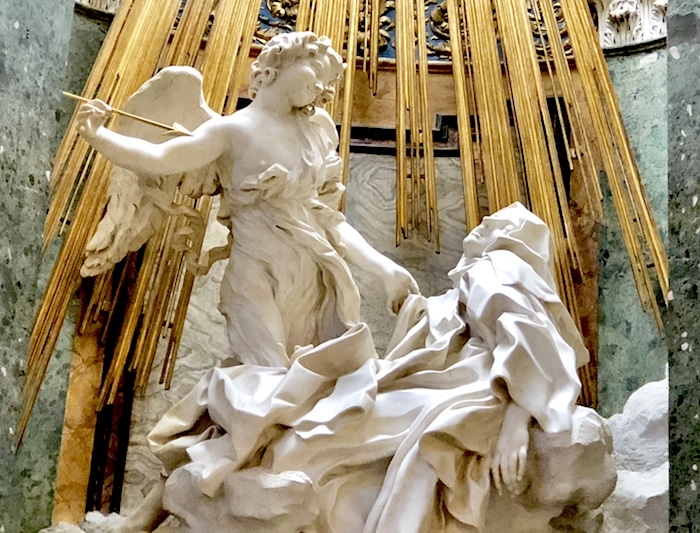
The Curious Case of the Ecstasy of Saint Teresa
Of all the Bernini statues in Rome, the Ecstasy of Saint Teresa in the Santa Maria della Vittoria Church is the most provocative.
While not a personal favourite of mine, it’s considered one of the best. Bernini himself was proud of it, calling it “the least bad thing I have ever done.”
The church isn’t far from the Rome Termini Train Station so it was easy to get to the next day from our hotel on the Via Veneto.
Mark put a coin in the box to light up the chapel and a dramatic vision appeared.
Bernini’s Statue of Saint Teresa
Saint Teresa, a Spanish mystic, reclines, a rapturous expression on her face.
A male angel stands over her. Gently he lifts her drapery, poised to pierce her heart with a golden spear.
The repeated thrust with the spear has produced a spiritual ecstasy in the saint.
Her arms fall to her sides, her drapery billows out in waves and golden rays shoot down from the sky. It’s, well, orgasmic. I don’t know how else to say it, and many art historians don’t either.
But maybe that’s too easy. Let’s call it spiritual sensuality and leave it at that. Or let’s look at how Saint Teresa herself describes it.
I saw a great golden spear, and at the iron tip there appeared to be a point of fire. This he plunged into my heart several times so that it penetrated to my entrails … The pain was so severe that it made me utter several moans. The sweetness caused by this intense pain is so extreme that one cannot possibly wish it to cease … — Saint Teresa
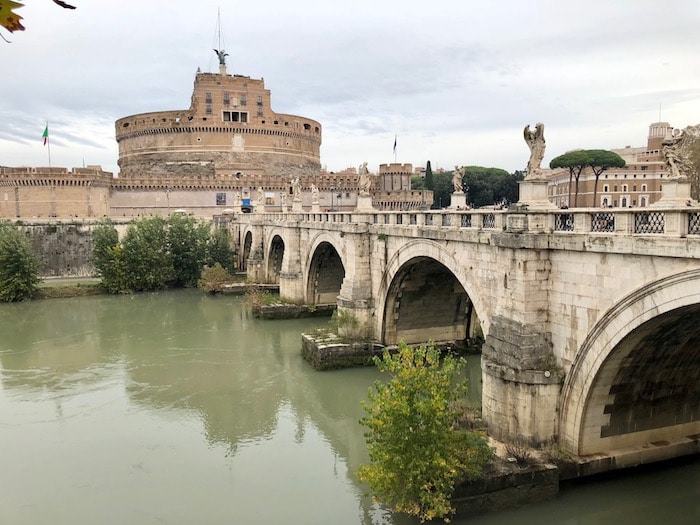
The Ponte Sant’Angelo – The Bridge of Angels
On our final morning in Rome, Mark and I found ourselves alone on the Ponte Sant’Angelo, the Bridge of Angels, after an early entry Vatican tour.
The Tiber was a milky jade, the sky a washed-out blue, and a row of marble angels lined our path.
I could almost hear the footsteps of the medieval pilgrims as they trudged over the bridge on the way to St Peter’s Basilica, this being the main passage to the Vatican.
The bridge dates back to 138 AD and was built by the Emperor Hadrian, long before the Baroque. So how does Bernini come into it?
In 1688 Pope Clement VII commissioned him to add the angels (only two of which Bernini carved himself).
It was Bernini in Rome at his best.
In fact, the pope declared the statues too exquisite to be batted about by the elements so he had copies made. The originals were moved to the church of Sant’Andrea delle Fratte, just off the Via Veneto, where they still are today.
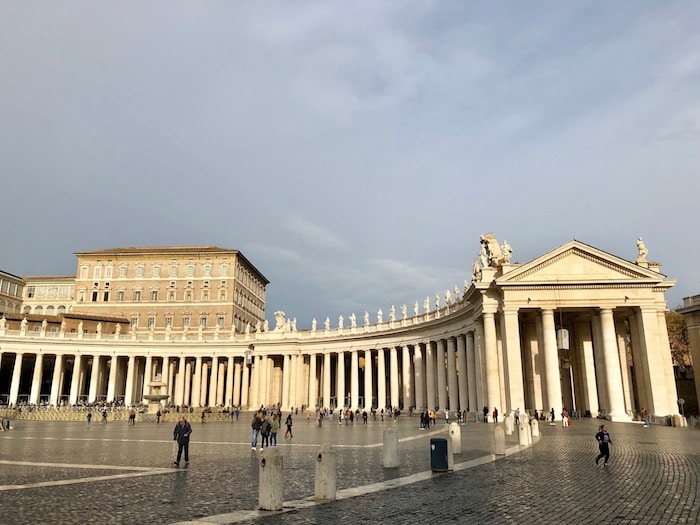
Bernini at the Vatican
From the Ponte Sant’Angelo it’s an easy walk to St. Peter’s Square, which Bernini designed for Pope Alexander VII.
The artist, a gifted architect as well as sculptor, created the two sweeping colonnades that represent the welcoming embrace of Christianity.
On the balustrade at the top of the columns there are 140 statues of saints crafted by his workshop. In the centre of the square is an Egyptian obelisk brought to Rome by Caligula in 37 AD.
Bernini’s Baldacchino in St Peter’s Basilica
Inside the basilica you can hardly miss Bernini’s Baldacchino.
Towering over the altar, which stands directly over St Peter’s tomb, Bernini’s Baldachin is a 29-metre bronze canopy. It’s an ornate work of art that comes complete with spiralling columns, gleaming angels and a golden cross at the top.
It took 11 years to make and the enormous amount of bronze needed for the project was pilfered from the Pantheon.

The Tomb of Pope Alexander II
The Tomb of Alexander II in the south transept of St. Peter’s was Bernini’s final design. It was completed when the artist was 81.
The pontiff, carved from white marble, kneels in prayer.
Below him, a bronze skeleton with insect-like wings emerges from a cloud of red Jasper drapery, an unsettling reminder of our own mortality.
Seeking warm flesh, I grasped my husband’s hand.
Surrounding the skeleton are four frothy figures. The represent Charity, Truth, Prudence and Judgement.
As Bernini worked on the tomb alongside his assistants, was he thinking about his own life and the roles Charity, Truth, Prudence and Judgement played in his choices?
And, I wondered, as we marvel over his sculptures today, do we think of the man’s genius or do we think of Costanza? Can you separate the art from the man?
However you choose to view Gian Lorenzo Bernini, there’s no denying he helped shape our image of Rome, as if the city was a magnificent piece of marble and it was his to design and create.
Wrap Up For Best Bernini Sculptures and Fountains in Rome
There’s no question that Rome is a great big Bernini showplace, and you could easily spend at least one day in Rome going from masterpiece to masterpiece – or more.
In fact, you can keep going right up until your husband says, with a desperate look on his face, that he’d like to start looking at Caravaggio paintings instead.
If you’re still after Bernini statues, here are a few more:
Bernini at the Capitoline Museum
At the Capitoline Museum you can see Bernini’s eerie Bust of Medusa, or find his whimsical Elephant and Obelisk sculpture in the Piazza della Minerva.
The Doria Pamphilj
At the Doria Pamphilj, you can see the bust of Pope Innocent X. It’s one of my favourite Bernini sculptures in Rome.
Bernini busts are known for their ‘Speaking Likeness’ – realistic portraits that look as if the subject was just taking a breath or about to speak.
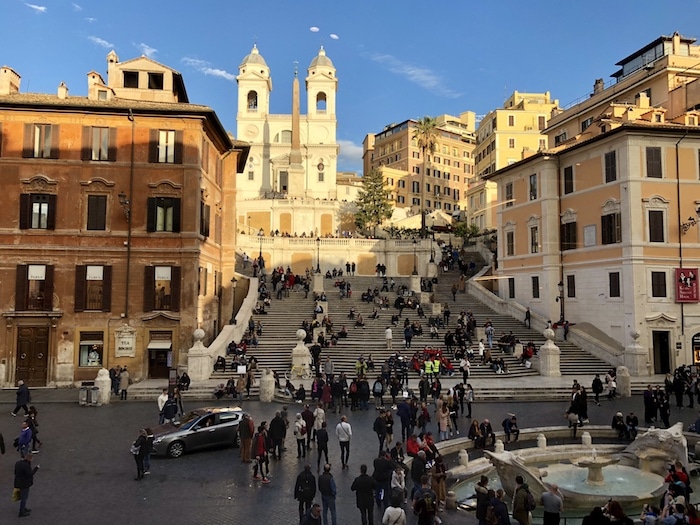
Fountain of the Leaky Boat at the Spanish Steps
Finally, at the bottom of the Spanish Steps you can see the Fountain of the Leaky Boat, the Fontana della Baraccia.
It was made by a very young Bernini and his artist father, Pietro Bernini. It’s not my top choice as far as Rome attractions go, but you’ll probably be at the Spanish Steps anyway.
And if you’ve made it this far, congratulations: You’ve seen the best of Bernini in Rome.
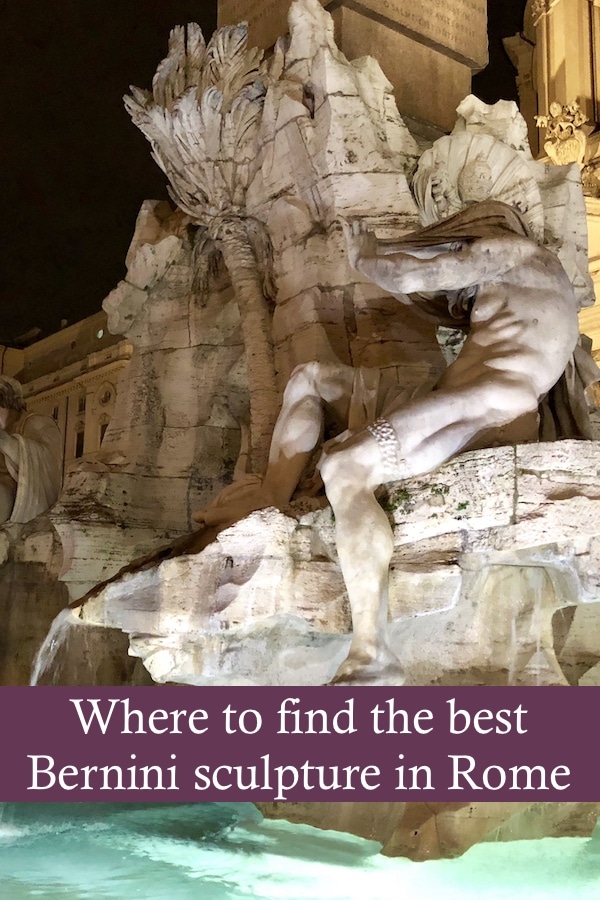
Read more: Looking for more unique ways to sightsee through the Eternal City? Read unusual things to do in Rome. Or read Cities in Italy and How to Fight with Your Husband in All of Them.
 Travel literature | Why travel and writing are lovers
Travel literature | Why travel and writing are lovers
Hi Ant, That is exactly how I feel about Bernini after seeing his sculptures in Rome. He was magic with marble, as if it was soft as silk in his hands.
Great Article. I spent 5 days following Bernini around Rome, absolutely incredible. The followed to London and Paris, however unable to see his work in Paris as they were on Strike at the Louvre. This man was an absolute genius, only Bernini can make Marble as delicate as a pillow.
Wonderful article. I love touring Italian cities based on the artwork found there. It really gives one insight not only into the art but into the city itself where the art was made.